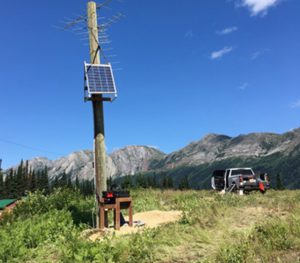Motus Wildlife Tracking System: Peace Basin expansion
This project, led by Birds Canada, will expand use of the Motus Wildlife Tracking System, to track birds and bats affixed with digitally-encoded radio transmitters. Results from this array can track animals across a diversity of landscapes, covering thousands of kilometres, and will support projects on key species, such as Little Brown Myotis bats. This project will involve community groups, installing stations at schools and other locations, to incorporate the Motus Education Program that builds knowledge about birds, bats, and conservation, for grades 7-12.
Update: New Motus stations installed to track birds and bats

Data collection about birds and bats in the Peace Region is about to get a boost from seven new receiver stations installed in 2021 to detect birds and bats affixed with digitally-encoded radio transmitters.
Better understanding of migration and habitat use could help inform future conservation actions planning for birds. And better understanding of bat movement and bat ecology is critical with the threat of the fatal white-nose syndrome.
The new stations will help track many species, including the at-risk northern long-eared bat, little brown bat, and olive-sided flycatcher.
The project, led by Birds Canada with funding from the FWCP, is a first for the Peace Region and will expand the use of the Motus Wildlife Tracking System in the province. The new Motus stations are located throughout Williston Reservoir, in the Pine Pass, and in wetland and agricultural areas east of the reservoir. Each station can detect signals up to a 10-kilometre radius under ideal conditions.


